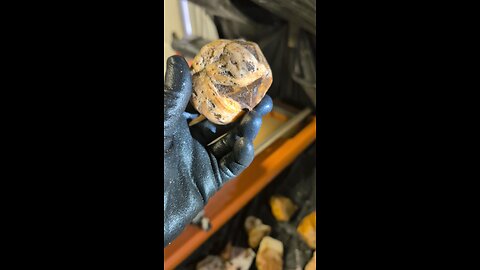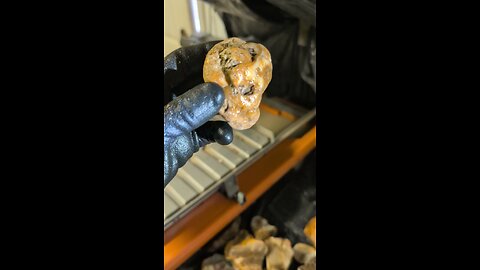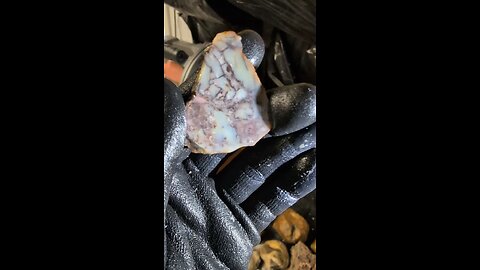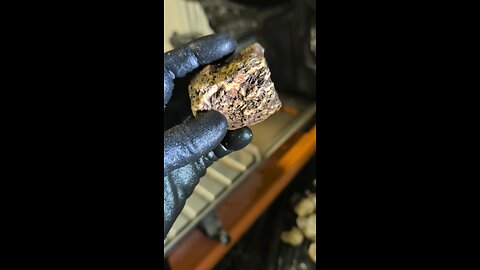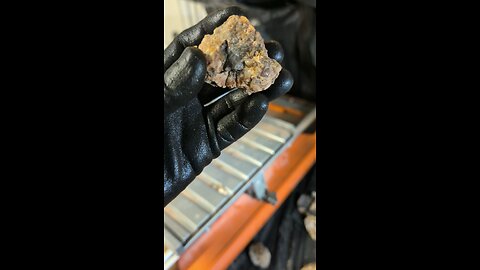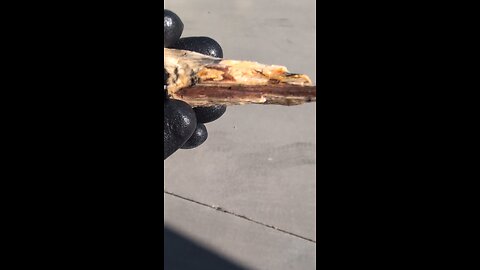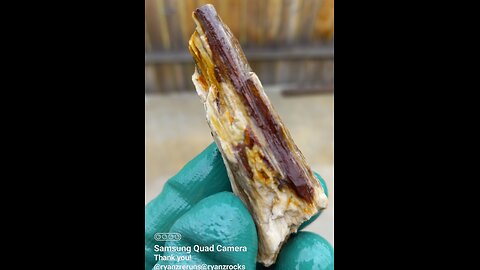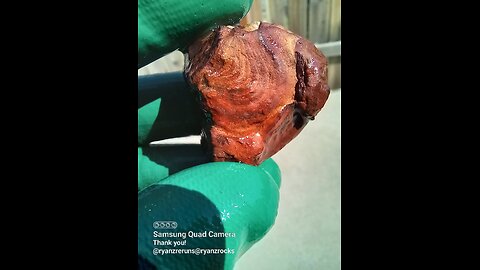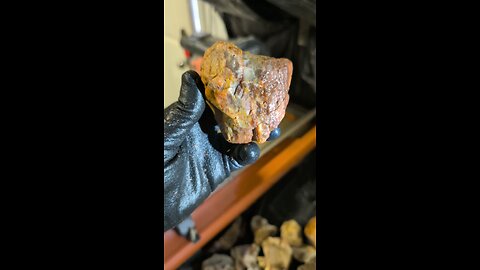
Petrified Wood!
11 videos
Updated 6 months ago
Petrified wood forms after a tree trunk becomes covered by wet mud composed of fine sediments or volcanic ash. Water keeps the wood from decaying quickly, and the mud provides silica that gradually replaces the wood's cells with quartz, opal, or chalcedony (all are forms of silica).
-
Agatized wood!
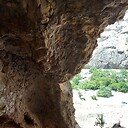 HumbleConservativeThis looks like petrified wood. The distinct wood grain pattern visible on the surface, combined with the stone-like texture and the various colors, are strong indicators of petrified wood. Petrification is a process where organic material is replaced by minerals, essentially turning wood into stone while preserving its original structure. The colors are often due to the minerals present during the petrification process.55 views
HumbleConservativeThis looks like petrified wood. The distinct wood grain pattern visible on the surface, combined with the stone-like texture and the various colors, are strong indicators of petrified wood. Petrification is a process where organic material is replaced by minerals, essentially turning wood into stone while preserving its original structure. The colors are often due to the minerals present during the petrification process.55 views -
Petrified wood ball!
 HumbleConservativeThis looks like petrified wood. The distinct wood grain pattern visible on the surface, combined with the stone-like texture and the various colors, are strong indicators of petrified wood. Petrification is a process where organic material is replaced by minerals, essentially turning wood into stone while preserving its original structure. The colors are often due to the minerals present during the petrification process.69 views
HumbleConservativeThis looks like petrified wood. The distinct wood grain pattern visible on the surface, combined with the stone-like texture and the various colors, are strong indicators of petrified wood. Petrification is a process where organic material is replaced by minerals, essentially turning wood into stone while preserving its original structure. The colors are often due to the minerals present during the petrification process.69 views -
Agatized wood!
 HumbleConservativeThis rock appears to be agatized wood, also known as petrified wood with agate. Here's why: * Wood Grain Presence: You can still see the distinct wood grain structure, indicating it was once wood. * Agate Inclusions: The darker, bubbly or layered formations within the wood grain are likely agate. Agate is a type of chalcedony (a form of quartz) that often fills voids and replaces organic material in petrified wood. * Color Variation: The mix of earthy tones (browns, tans, creams) along with the darker, more translucent areas (likely the agate) is typical of agatized wood. Agatized wood is a fascinating combination of fossilized wood and agate, making it a popular material for collectors and lapidary artists.59 views
HumbleConservativeThis rock appears to be agatized wood, also known as petrified wood with agate. Here's why: * Wood Grain Presence: You can still see the distinct wood grain structure, indicating it was once wood. * Agate Inclusions: The darker, bubbly or layered formations within the wood grain are likely agate. Agate is a type of chalcedony (a form of quartz) that often fills voids and replaces organic material in petrified wood. * Color Variation: The mix of earthy tones (browns, tans, creams) along with the darker, more translucent areas (likely the agate) is typical of agatized wood. Agatized wood is a fascinating combination of fossilized wood and agate, making it a popular material for collectors and lapidary artists.59 views -
Opalized wood!
 HumbleConservativeThis rock looks like opalized wood or opalized petrified wood. Here's why: * Wood Grain Texture: You can see the distinct grain and texture of wood, indicating it was once a piece of a tree or branch. * Opal-like Sheen/Color: The light blue, almost milky appearance with hints of other colors (like the brown you see in the center) is characteristic of opal. Opal is a mineraloid that often replaces organic materials, including wood. * Fracturing: The way the surface is cracked or shows a "crazed" pattern is also common in opal, as it can be somewhat brittle. Opalized wood forms when silica-rich solutions infiltrate wood and replace the organic material with opal, preserving the wood's form. The presence of opal gives it a unique look compared to other types of petrified wood.71 views
HumbleConservativeThis rock looks like opalized wood or opalized petrified wood. Here's why: * Wood Grain Texture: You can see the distinct grain and texture of wood, indicating it was once a piece of a tree or branch. * Opal-like Sheen/Color: The light blue, almost milky appearance with hints of other colors (like the brown you see in the center) is characteristic of opal. Opal is a mineraloid that often replaces organic materials, including wood. * Fracturing: The way the surface is cracked or shows a "crazed" pattern is also common in opal, as it can be somewhat brittle. Opalized wood forms when silica-rich solutions infiltrate wood and replace the organic material with opal, preserving the wood's form. The presence of opal gives it a unique look compared to other types of petrified wood.71 views -
Petrified Bark Cut!
 HumbleConservativeBased on the image, the petrified wood appears to have a vibrant mix of colors, predominantly orange, brown, and white. This type of coloration is often associated with petrified wood from certain regions known for their unique mineralization processes. Here are a few possibilities: Arizona Petrified Wood: Known for its vibrant colors, especially reds, oranges, and yellows, due to the presence of iron oxides. Oregon Petrified Wood: Also known for its colorful specimens, often with similar orange and brown hues, due to the mineral content in the region. Washington Petrified Wood: Can have a similar color palette, though often with more varied patterns due to the geological history.40 views
HumbleConservativeBased on the image, the petrified wood appears to have a vibrant mix of colors, predominantly orange, brown, and white. This type of coloration is often associated with petrified wood from certain regions known for their unique mineralization processes. Here are a few possibilities: Arizona Petrified Wood: Known for its vibrant colors, especially reds, oranges, and yellows, due to the presence of iron oxides. Oregon Petrified Wood: Also known for its colorful specimens, often with similar orange and brown hues, due to the mineral content in the region. Washington Petrified Wood: Can have a similar color palette, though often with more varied patterns due to the geological history.40 views -
Grey dendrites!
 HumbleConservativeThis petrified wood shows a mix of brown, orange, and some white crystalline inclusions. The patterns and colors suggest it might be from a region known for such mineralization. Here are a few possibilities: Arizona Petrified Wood: This type often features vibrant colors with intricate patterns due to iron oxides and other minerals. Oregon Petrified Wood: Known for its colorful specimens with similar patterns, often due to the presence of silica and other minerals. Washington Petrified Wood: This can also display similar characteristics, with unique patterns due to the geological processes in the area. The white crystalline inclusions could be quartz or calcite, which are common in petrified wood.49 views
HumbleConservativeThis petrified wood shows a mix of brown, orange, and some white crystalline inclusions. The patterns and colors suggest it might be from a region known for such mineralization. Here are a few possibilities: Arizona Petrified Wood: This type often features vibrant colors with intricate patterns due to iron oxides and other minerals. Oregon Petrified Wood: Known for its colorful specimens with similar patterns, often due to the presence of silica and other minerals. Washington Petrified Wood: This can also display similar characteristics, with unique patterns due to the geological processes in the area. The white crystalline inclusions could be quartz or calcite, which are common in petrified wood.49 views -
Petrified wood!
 HumbleConservativePetrified wood is a type of fossil where the organic materials of a tree or tree-like plant have been replaced by minerals, preserving the original structure of the wood in stone form. Here are some key details about petrified wood: Formation: The process of petrifaction involves several steps: Burial: The wood must be buried quickly in sediment, usually in environments like river floodplains or volcanic ash deposits, to prevent decay. Mineralization: Groundwater rich in dissolved minerals, primarily silica (but can also include iron, manganese, or other minerals), seeps into the wood. Over time, the minerals precipitate out of the water and replace the organic material cell by cell, effectively turning the wood into stone while maintaining its original structure. Recrystallization: The silica often recrystallizes into quartz, preserving the cellular structure of the wood in fine detail. Composition: While the primary mineral in petrified wood is often quartz, other minerals like calcite, pyrite, or oxides of iron and manganese can also be involved, contributing to the variety of colors seen in petrified wood. Texture: Petrified wood retains the texture of the original wood, with growth rings, knots, and even bark sometimes visible. The texture can range from fine-grained to coarse, depending on the degree of mineral replacement and the type of wood. Color: The color of petrified wood varies widely based on the minerals involved in the replacement process: Silica: Usually results in white, gray, or clear petrified wood. Iron Oxides: Can give shades of red, yellow, or brown. Manganese Oxides: Often produce black or dark brown colors. Copper Compounds: Can result in green or blue hues. Uses: Decorative: Petrified wood is popular in home decor, used for making furniture, tabletops, bookends, and as display pieces due to its unique beauty and historical significance. Jewelry: Slices or small pieces of petrified wood can be polished and used in jewelry, especially when colorful or with interesting patterns. Scientific Study: It's valuable in paleobotany for understanding ancient forests, plant evolution, and the environmental conditions of the past. Geological Significance: Petrified wood provides a window into ancient ecosystems, showing what types of vegetation existed millions of years ago. It's also a record of geological processes like volcanic activity, flooding, or changes in river courses that led to the burial and preservation of the wood.49 views
HumbleConservativePetrified wood is a type of fossil where the organic materials of a tree or tree-like plant have been replaced by minerals, preserving the original structure of the wood in stone form. Here are some key details about petrified wood: Formation: The process of petrifaction involves several steps: Burial: The wood must be buried quickly in sediment, usually in environments like river floodplains or volcanic ash deposits, to prevent decay. Mineralization: Groundwater rich in dissolved minerals, primarily silica (but can also include iron, manganese, or other minerals), seeps into the wood. Over time, the minerals precipitate out of the water and replace the organic material cell by cell, effectively turning the wood into stone while maintaining its original structure. Recrystallization: The silica often recrystallizes into quartz, preserving the cellular structure of the wood in fine detail. Composition: While the primary mineral in petrified wood is often quartz, other minerals like calcite, pyrite, or oxides of iron and manganese can also be involved, contributing to the variety of colors seen in petrified wood. Texture: Petrified wood retains the texture of the original wood, with growth rings, knots, and even bark sometimes visible. The texture can range from fine-grained to coarse, depending on the degree of mineral replacement and the type of wood. Color: The color of petrified wood varies widely based on the minerals involved in the replacement process: Silica: Usually results in white, gray, or clear petrified wood. Iron Oxides: Can give shades of red, yellow, or brown. Manganese Oxides: Often produce black or dark brown colors. Copper Compounds: Can result in green or blue hues. Uses: Decorative: Petrified wood is popular in home decor, used for making furniture, tabletops, bookends, and as display pieces due to its unique beauty and historical significance. Jewelry: Slices or small pieces of petrified wood can be polished and used in jewelry, especially when colorful or with interesting patterns. Scientific Study: It's valuable in paleobotany for understanding ancient forests, plant evolution, and the environmental conditions of the past. Geological Significance: Petrified wood provides a window into ancient ecosystems, showing what types of vegetation existed millions of years ago. It's also a record of geological processes like volcanic activity, flooding, or changes in river courses that led to the burial and preservation of the wood.49 views -
Piece of Petrified Wood!
 HumbleConservative@RyanzRocks #noob #rockhound #rockformation #tumbling #agates #rocks #rockhounders #rockstructure #metamorphicrocks #metamorphic #igneousrocks #igneous #quartz #quartzite #geology #nodules #minerals #crystals #glowrocks #idahorockhunting #idahogems #rockcutting #thundereggs #chalcedony #opal #lavarock #rigidtools #ryobitools #riverrocks #translucentrocks #translucent #rockgarden #flow #vevortools #jasper #granite #caves #marble #carnelian #gneiss #limestone #calcite #gold #silver #botryoidal1 view
HumbleConservative@RyanzRocks #noob #rockhound #rockformation #tumbling #agates #rocks #rockhounders #rockstructure #metamorphicrocks #metamorphic #igneousrocks #igneous #quartz #quartzite #geology #nodules #minerals #crystals #glowrocks #idahorockhunting #idahogems #rockcutting #thundereggs #chalcedony #opal #lavarock #rigidtools #ryobitools #riverrocks #translucentrocks #translucent #rockgarden #flow #vevortools #jasper #granite #caves #marble #carnelian #gneiss #limestone #calcite #gold #silver #botryoidal1 view -
Petrified Wood!
 HumbleConservative@RyanzRocks #noob #rockhound #rockformation #tumbling #agates #rocks #rockhounders #rockstructure #metamorphicrocks #metamorphic #igneousrocks #igneous #quartz #quartzite #geology #nodules #minerals #crystals #glowrocks #idahorockhunting #idahogems #rockcutting #thundereggs #chalcedony #opal #lavarock #rigidtools #ryobitools #riverrocks #translucentrocks #translucent #rockgarden #flow #vevortools #jasper #granite #caves #marble #carnelian #gneiss #limestone #calcite #gold #silver #botryoidal30 views
HumbleConservative@RyanzRocks #noob #rockhound #rockformation #tumbling #agates #rocks #rockhounders #rockstructure #metamorphicrocks #metamorphic #igneousrocks #igneous #quartz #quartzite #geology #nodules #minerals #crystals #glowrocks #idahorockhunting #idahogems #rockcutting #thundereggs #chalcedony #opal #lavarock #rigidtools #ryobitools #riverrocks #translucentrocks #translucent #rockgarden #flow #vevortools #jasper #granite #caves #marble #carnelian #gneiss #limestone #calcite #gold #silver #botryoidal30 views -
